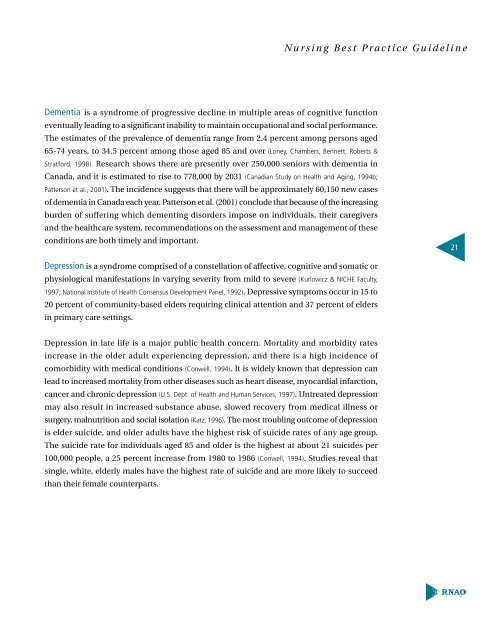Screening for Delirium, Dementia and Depression in Older Adults
Screening for Delirium, Dementia and Depression in Older Adults
Screening for Delirium, Dementia and Depression in Older Adults
- No tags were found...
You also want an ePaper? Increase the reach of your titles
YUMPU automatically turns print PDFs into web optimized ePapers that Google loves.
Nurs<strong>in</strong>g Best Practice Guidel<strong>in</strong>e<strong>Dementia</strong> is a syndrome of progressive decl<strong>in</strong>e <strong>in</strong> multiple areas of cognitive functioneventually lead<strong>in</strong>g to a significant <strong>in</strong>ability to ma<strong>in</strong>ta<strong>in</strong> occupational <strong>and</strong> social per<strong>for</strong>mance.The estimates of the prevalence of dementia range from 2.4 percent among persons aged65-74 years, to 34.5 percent among those aged 85 <strong>and</strong> over (Loney, Chambers, Bennett, Roberts &Strat<strong>for</strong>d, 1998). Research shows there are presently over 250,000 seniors with dementia <strong>in</strong>Canada, <strong>and</strong> it is estimated to rise to 778,000 by 2031 (Canadian Study on Health <strong>and</strong> Ag<strong>in</strong>g, 1994b;Patterson et al., 2001). The <strong>in</strong>cidence suggests that there will be approximately 60,150 new casesof dementia <strong>in</strong> Canada each year. Patterson et al. (2001) conclude that because of the <strong>in</strong>creas<strong>in</strong>gburden of suffer<strong>in</strong>g which dement<strong>in</strong>g disorders impose on <strong>in</strong>dividuals, their caregivers<strong>and</strong> the healthcare system, recommendations on the assessment <strong>and</strong> management of theseconditions are both timely <strong>and</strong> important.21<strong>Depression</strong> is a syndrome comprised of a constellation of affective, cognitive <strong>and</strong> somatic orphysiological manifestations <strong>in</strong> vary<strong>in</strong>g severity from mild to severe (Kurlowicz & NICHE Faculty,1997; National Institute of Health Consensus Development Panel, 1992). Depressive symptoms occur <strong>in</strong> 15 to20 percent of community-based elders requir<strong>in</strong>g cl<strong>in</strong>ical attention <strong>and</strong> 37 percent of elders<strong>in</strong> primary care sett<strong>in</strong>gs.<strong>Depression</strong> <strong>in</strong> late life is a major public health concern. Mortality <strong>and</strong> morbidity rates<strong>in</strong>crease <strong>in</strong> the older adult experienc<strong>in</strong>g depression, <strong>and</strong> there is a high <strong>in</strong>cidence ofcomorbidity with medical conditions (Conwell, 1994). It is widely known that depression canlead to <strong>in</strong>creased mortality from other diseases such as heart disease, myocardial <strong>in</strong>farction,cancer <strong>and</strong> chronic depression (U.S. Dept. of Health <strong>and</strong> Human Services, 1997). Untreated depressionmay also result <strong>in</strong> <strong>in</strong>creased substance abuse, slowed recovery from medical illness orsurgery, malnutrition <strong>and</strong> social isolation (Katz, 1996). The most troubl<strong>in</strong>g outcome of depressionis elder suicide, <strong>and</strong> older adults have the highest risk of suicide rates of any age group.The suicide rate <strong>for</strong> <strong>in</strong>dividuals aged 85 <strong>and</strong> older is the highest at about 21 suicides per100,000 people, a 25 percent <strong>in</strong>crease from 1980 to 1986 (Conwell, 1994). Studies reveal thats<strong>in</strong>gle, white, elderly males have the highest rate of suicide <strong>and</strong> are more likely to succeedthan their female counterparts.
















